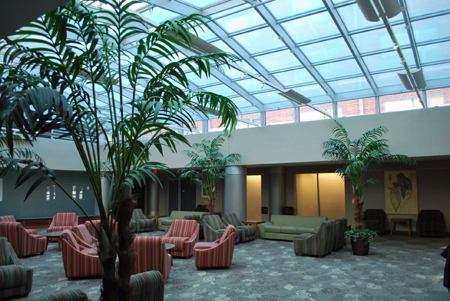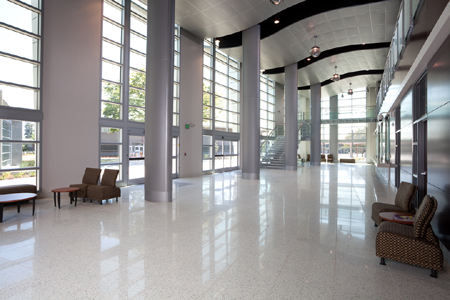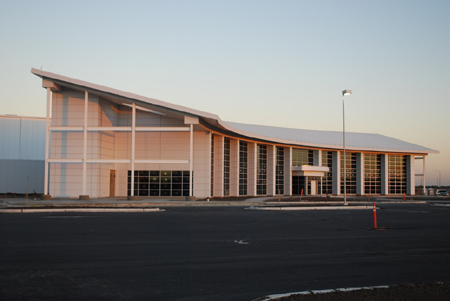Windows have long been a conundrum in the green building world. On one hand, they allow for natural daylighting and a free source of heat when the sun is shining. On the other hand, they also tend to create drafts in the winter and overheat occupants in the summer, both of which overburden the building’s heating and cooling system, wasting energy.
Electrochromic glass solves this problem by tinting to block the sun’s rays at the touch of a button, or based on a pre-set program. Currently, it’s expensive enough that the market for this specialty glass has been limited to high-end, high-profile architectural showpiece buildings–but with the recent announcement that two of the leaders in this technology, Sage and Saint Gobain, are teaming up to lower the cost of production, that could change.
To get a handle on what this could mean for the green building industry, we recently interviewed Jim Wilson, Sage’s Chief Marketing Officer:

EarthTechling (ET): Solar Thermal Magazine has called your product, SageGlass, “the world’s only commercially available, electronically ‘tintable’ window glass.” How was your technology developed? How does it work?
Jim Wilson (JW): SageGlass was developed using nanotechnology-based coatings consisting of five layers of ceramic materials, which have a total thickness that is less than 1/50th that of a human hair. When low voltage is applied, the electrons darken the ceramic coatings. Reversing the voltage polarity causes electrons to return to their original layer, and the glass clears. This solid state electrochromic reaction is controlled through a low voltage DC power supply. When the SageGlass coating darkens, the sun’s light and heat are absorbed and subsequently reradiated from the glass surface to the exterior – much the way low-emissivity glass also keeps out unwanted heat.
SageGlass can be switched from clear to darkly tinted at the click of a button, or programmed to respond to changing sunlight and heat conditions. For example, on hot, sunny days the tint in the windows will darken to reduce glare and block out heat. On cold, cloudy days the windows will clear to allow sunlight and heat to fill the office or home. The electrical switching of tints can be operated manually or integrated into an automated building management system. SageGlass modulates visible light transmission and solar heat gain, and, in the tinted condition, blocks 91 percent of the solar heat gain.
ET: SageGlass can be programmed to respond to changing conditions. What does that mean for building managers and homeowners?
JW: First, SageGlass controls can be integrated with a building or home management system, or activated at the push of a button to control the sunlight and heat that enters and leaves a building. It gives building managers and homeowners a new design option that solves the age-old conundrum of how to increase daylight for the well-being of occupants while stopping glare, excessive solar heat and fading all without blocking the view. This creates new possibilities for the design of a building’s interior space and its external appearance, minimizing the need for energy-consuming devices such as air conditioners. Like a second transparent skin, this technology is unrivaled in optimizing the functions of glass surfaces exposed to the sun.
Secondly, for building managers, SageGlass makes their buildings more marketable and desirable. SageGlass enables more beautiful buildings that are pleasant places to live and work. Studies have shown that daylight in buildings boosts the health and productivity of the people inside. Workers have fewer health complaints, are more resistant to fatigue and stress, and are more satisfied with their jobs than windowless workers.

ET: Your product blocks the heat of solar gain while still allowing for natural daylighting, two key elements of energy-efficient buildings. How does the use of SageGlass affect the overall energy footprint of a building?
JW: SageGlass transforms windows from an energy liability in buildings to an energy source, because energy loss through windows accounts for about 30 percent of heating and cooling energy. According to the U.S. Department of Energy’s (DOE) Lawrence Berkeley National Laboratory (LBNL), SageGlass “has the potential to reduce building heating and air conditioning equipment size by up to 25 percent, resulting in construction cost savings. SageGlass could also potentially reduce overall cooling loads for commercial buildings up to 20 percent by lowering peak power demand and may reduce lighting costs by up to 60 percent while providing building occupants with more natural daylight and greater comfort.”
And when you extrapolate the energy footprint of SageGlass-equipped buildings across the U.S., the energy savings are even more dramatic. The DOE said that the technology’s daylighting and solar gain control have the potential of reducing the annual U.S. energy consumption by several quadrillion (1015) BTUs, or quads, which is approximately five percent of the nation’s total energy budget.

ET: Until now, electrochromic glass has largely been an emerging product, not widely adopted due to cost. You recently received a sizable investment from Saint Gobain, one of the world’s largest glass manufacturers, which will allow SageGlass to be produced at unprecedented economies of scale. How will improved economies affect the price of your product? How do you expect these changes to affect the overall market for this glass?
JW: While electrochromic glass has existed as an expensive architectural specialty product for many years, the SAGE/Saint-Gobain project marks the first time the technology will be manufactured in high quantities at an affordable price point, and in the large sizes required for curtain wall and other commercial and residential building applications. Our companies have more than 40 years of combined R&D experience and 100 patents developing advanced glazing products, all of which will come to bear on our new state-of-the-art facility.
The facility will manufacture much larger sheets of glass that have so far been unavailable in the market, meeting the needs of 95 percent of available global building opportunities. The glass will be produced at an affordable price point in high volume, with an annual production capacity of four million square feet.
ET: You could have chosen to build your new 300,000 glass factory anywhere in the country. Why Faribault, Minnesota?
JW: Faribault is the location of SAGE’s worldwide headquarters and its current 60,000 square-foot commercial production facility. Once the new high volume manufacturing plant is completed, the current plant will serve as a dedicated R&D facility. The proximity of the two facilities creates great efficiencies in regards to engineering and production resources. Minnesota, which has been called “the Silicon Valley of the window industry”, is also a great source of talent for SAGE as it is home to many major players in the glass industry, including industry leading glass fabricators and window manufacturers.